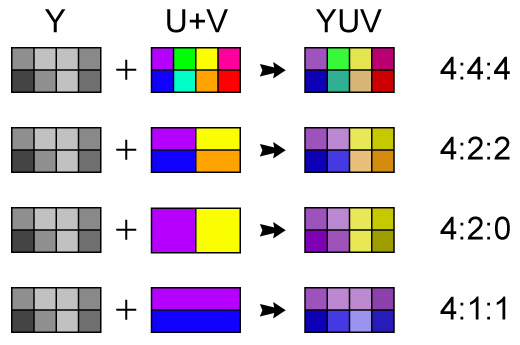A Primer on Chroma Subsampling and What It Means In Practical Terms
 This is not a switcher wars post. I have no interest in discussing the various claims made by one manufacturer or another, the counter claims, counter-counter claims or any other such back-and-forth between competitors. The issue to which some of the ongoing discussion about switching technology HAS brought more attention is that of chroma subsampling, and what it means in practical terms. What I’ve found reviewing one of these claims is not what I expected; I’d come to the point at which I accepted 4:2:2 as not only “good enough” but indistinguishable from 4:4:4 for any practical purposes. Recent demonstrations and exploration has shown that — depending on content and use case — I was not correct in this.
This is not a switcher wars post. I have no interest in discussing the various claims made by one manufacturer or another, the counter claims, counter-counter claims or any other such back-and-forth between competitors. The issue to which some of the ongoing discussion about switching technology HAS brought more attention is that of chroma subsampling, and what it means in practical terms. What I’ve found reviewing one of these claims is not what I expected; I’d come to the point at which I accepted 4:2:2 as not only “good enough” but indistinguishable from 4:4:4 for any practical purposes. Recent demonstrations and exploration has shown that — depending on content and use case — I was not correct in this.
For those who aren’t clear on the topic, chroma subsampling is the practice of sampling the color of a video signal (chroma) at a lesser rate than the brightness (luminance). In the YCbCr color space, this is simply a matter of sampling the Y value at a lesser rate than the Cb and Cr (blue-difference and red-difference) components. The attached illustration shows how this affects an image, as you can clearly see, information is lost.
This has become a common practice in 4K video transmission to reduce bandwidth requirements; 4K video requires four times the bandwidth of 1920×1080 video, which was already near the technical limitations of current transport technology. In order to fit more pixels into the same bandwidth, the choices are to either reduce the frame rate, reduce the amount of data per pixel or both. See, for example, the “True4K” specification from Extron, listing the available resolutions, chroma subsampling and color depth for a matrix-switch input board. Note that in order to increase chroma subsampling, one must reduce the frame rate and vice-versa.
This has seemed like a reasonable tradeoff because of the human eye’s greater sensitivity to light than to color. The concept behind this choice is that the human eye and brain will fill in the “missing” chroma information far better than they would fill in missing luma. In fact, Blu-ray and DVD discs typically sample at 4:2:0. We’re accustom to this, and it seems to make little difference.
Did you notice the assumption in the above paragraphs? The human eye will fill in missing chroma information from one frame to the next. What if the image is static? Even worse, what if the image is static and consists of very narrow (as narrow as a single-pixel width) bands of color? This is a case in which the appropriateness of the solution is highly dependent on content.
One switch manufacturer has been passing around a demo with what we in our office are referring to as a “chroma torture image.” The image in question consists of a series of very narrow single-color borders, a polar array of single-pixel lines in various colors and a column of text. Their contention is that scalers that do not maintain 4:4:4 chroma subsampling will have weakness in displaying such an image. From the demonstrations I’ve seen, this certainly appears to be true. What’s more, some “regular” content not chosen as a chroma stress test (Excel spreadsheets are particularly bad for this) will show similar — albeit less dramatic — artifacts. Independent testing reveals that these effects are real.
So end of story. Right?
Maybe.
Repeating the test under varying conditions reveals interesting results. The artifacts, which were so disturbing in the case of upscaled 1920×1080 content, disappear completely when viewing 4K content. Clearly this particular product only has chroma subsampling issues in its scaler.
What does that mean?
Broadly, it means that not all devices handle all content identically. Scaled content is not the same as content viewed at its native resolution, nor is video content the same as static content. As is always the case, content matters.
It also highlights the fact that some pitfalls don’t appear in the published specifications. It highlights that even the very best products (and the products we are discussing are among the best) have weaknesses. It also highlights the risk of dismissing a piece of gear as “inferior” before considering one’s use case, including types of sources.
With 4K now a fact of life and 8K video possibly around the corner compromises between quality and bandwidth will remain a fact of life. As is the case with anything else, we need to know what we’re giving up, what we’re risking and what it means in each particular circumstance.
Again, this is not a switcher wars post. I see considerable value in the product offerings and ecosystems of several manufacturers. This is, as always, a call for mindfulness.





